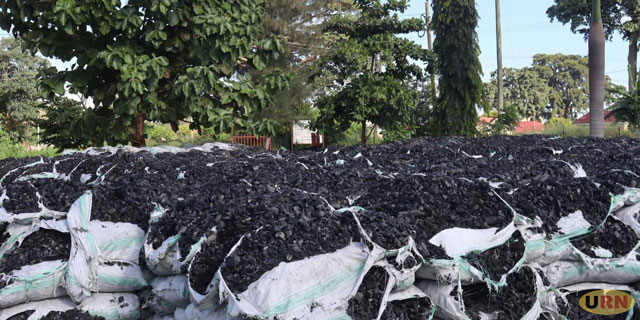
Gulu, Uganda | THE INDEPENDENT | Thousands of sacks of charcoal impounded by law enforcement officers in the Acholi Sub-region are exposed to rain and wasting away, three months after the Gulu Chief Magistrates Court ordered their disposal through public auctioning.
On July 12, Gulu Chief Magistrate Said Barigye in a ruling ordered the auctioning of 1,877 bags of charcoal that were impounded by the National Forestry Authority (NFA) personnel and the Environmental Police Protection Unit (EPPU).
The illegal forest products were impounded in June from eight businessmen at the checkpoints of Akurukwe in Amuru District, Layibi in Gulu City, and Bobi in Omoro District being transported out of the Acholi Sub-region. However, three months, after the court ruling, the sacks of charcoal now totaling 6,673 that are being kept at the NFA Gulu city offices in Pece-Laroo Division are yet to be disposed of.
On Friday, our reporter visited the site and found most of the charcoal bags torn due to long exposure to the sun and rain leaving the charcoal exposed. John Giribo, the NFA Range Manager of Aswa River Range told Uganda Radio Network Friday that the delayed auctioning of impounded charcoal was due to the lengthy procurement processes for an auctioneer.
Giribo however says NFA finally acquired an auctioneer firm, M/s Intrepid Recovery Associates Ltd last week that will conduct the auctioning of the charcoal before the end of this month.
He says the auctioneer inspected the site on Friday where the impounded sacks of charcoal are being kept or oriented and is expected to provide a comprehensive work plan for auctioning the charcoal.
Giribo notes that while NFA has tirelessly worked to curb the charcoal vice in the sub-region, it faces challenges of limited facilitation which has affected its operations to monitor all areas being degraded for charcoal production. According to him, more than 50 suspects have been arrested and charged in connection to the illegal charcoal trade over the past months since the implementation of Executive Order No. 3 kicked off in May in the districts of Amuru and Gulu.
State Minister for Northern Uganda Rehabilitation Grace Freedom Kwiyucwyiny says such delays in the auctioning of impounded illegal forest products frustrate the implementation of Executive Order No. 3. Kwyiyucwyiny notes that she intends to raise the matter before the Ministry of Water and Environment to consider allowing NFA to proceed with the auctioning of impounded charcoal immediately after court rulings.
“I want to get advice from the Ministry of Water and Environment. After the court has ruled, why should it take more than a month? The auctioning should be done there and then,” says Kwiyucwyiny. She also revealed that while there is an ongoing ban on the commercial production of charcoal and trade, the vice is still being conducted by businessmen who now use box body trucks instead of open trucks like in the past.
George Ebola, an environmental activist and member of “Our Trees We Need Answer” suspects foul play in the delayed auctioning of the impounded charcoal alleging that it could have been deliberate to blindfold people on implementation of the Executive Order.
In May this year, President Museveni signed Executive Order No. 3 banning tree cutting for commercial charcoal production in Northern and Northeastern Uganda. The President faulted the corrupt elements in security forces and officials in charge of the Environment and National Forestry Authority (NFA) for allegedly aiding the rising charcoal trade.
Acholi Sub-region has witnessed a drastic decline in forest covers over the past years owing to the growing demand for charcoal and timber. According to the Global Forest Watch report, Gulu district alone lost 38.7kha of tree cover, equivalent to a 6.2 percent decrease in tree cover from 2001 to 2021, with the largest portion of the forest cover destroyed for charcoal production and timber.
*****
URN
 The Independent Uganda: You get the Truth we Pay the Price
The Independent Uganda: You get the Truth we Pay the Price



